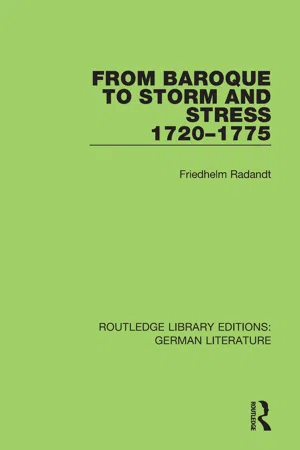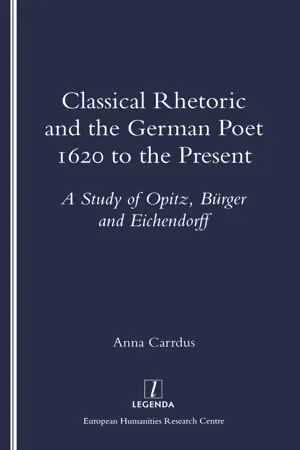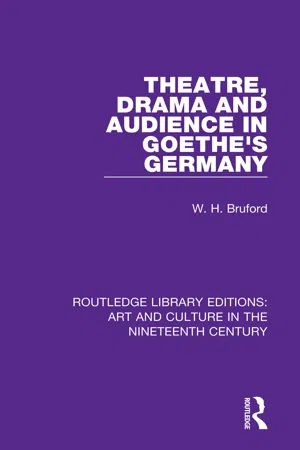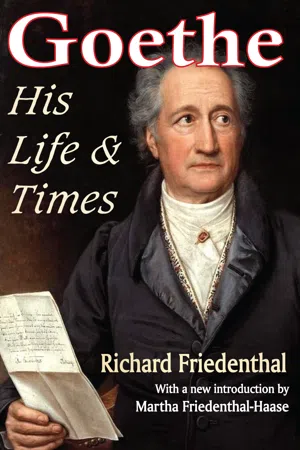Literature
Sturm und Drang
Sturm und Drang was a German literary movement in the late 18th century characterized by its emphasis on intense emotions, individualism, and rebellion against societal norms. It sought to capture the raw and untamed aspects of human experience, often through themes of nature, passion, and the supernatural. The movement had a significant influence on the Romantic movement that followed.
Written by Perlego with AI-assistance
Related key terms
5 Key excerpts on "Sturm und Drang"
- eBook - ePub
Counterparts
The Dynamics of Franco-German Literary Relationships 1770-1895
- Lilian R. Furst(Author)
- 2020(Publication Date)
- Routledge(Publisher)
It is a bewildering assortment that defies comprehension unless the fundamental dualism of the Sturm und Drang is clearly posited. In this context the ambiguity of the German word Drang is of paramount importance. For there is something schizophrenic in the Sturm und Drang, in the movement as a whole and in its individual manifestations. The aggressive momentum, the forward thrust implicit in Sturm and in one sense of Drang seems to be in contradiction to the withdrawal under outer and inner pressures that is strongly inferred in the second half of the German phrase. Or, to translate the problem into concrete terms, the dynamic energy of Götz von Berlichingen, Karl Moor and all the supermen in the plays of Klinger, Wagner and Leisewitz is the diametric opposite to the yielding melancholy of Werther and of Lenz’s ‘Waldbruder’ (‘sylvan brother’). On the one side stand the strident, extrovert heroes and on the other the passive, introvert anti-heroes. And both faces are equally typical of the Sturm und Drang. Nowhere are these conflicting elements more plainly apparent or more closely interrelated than in the Urfaust fragment which dates from the early 1770s. Faust’s later self-diagnosis of the two souls within himself (‘Zwei Seelen wohnen, ach! in meiner Brust)’ 1 is already amply substantiated in the opening monologue of the play. In an emotional revulsion against the hollow sham of the life he has been leading, his dominant drive is towards rebellion. He thirsts for mysterious knowledge, instinctive insight into the innermost workings of the universe in place of the dry, sterile academic learning, in the value of which he no longer believes. Yet even as he expresses this craving, he sinks back into a mood of despair in which death seems the only solution. In its tempo and language too the elegaic apostrophe to the moon acts as a foil to the vehement outbursts with which the play’s opening monologue begins - eBook - ePub
- Friedhelm Radandt(Author)
- 2020(Publication Date)
- Routledge(Publisher)
Die Deutsche Chronik (1774–1777). In that role he resembles Claudius. The impact of his writing was heightened by the fact that he spent ten years (1777–1787) imprisoned, without trial and without verdict, in the famous Hohenasperg fortress. Duke Karl Eugen of Württemberg whose monstrous tyranny was to cause Schiller to flee his realm in later years, had ordered the imprisonment as a move to quiet the discomforting voice of Schubart. Earlier the poet had been expelled from Württemberg because of his openly immoral ways at court. He wrote much of his poetry on the Hohenasperg, which in the poem ‘Die Aussicht’ he calls the ‘mount of tears’. His poetry speaks of his deep faith in God, which enables him to endure his sufferings patiently. His most famous poem, written during the imprisonment, he entitled ‘Die Fürstengruft’. In it he attacks tyrannical lords. He imagines looking at the decaying bodies of dead princes in their burial vault, and he remembers the inhumanity of many a proud ruler. Seemingly, he is speaking of his own fate when he claims that outspokenness has often led to incarceration:Nun ist die Hand herabgefault zum Knochen, Die oft mit kaltem Federzug Den Weisen, der am Thron zu laut gesprochen, In harte Fesseln schlug.Schubart’s work made a definite impression on the youthful Schiller, who was inspired to his first drama, Die Räuber (1781), by a story from Schubart’s pen.V A Critical Look at the Period: Lichtenberg
Sturm und Drang as a movement in German literary history was as effective as it was short-lived. Like most intellectual movements it had its formidable critics, mostly among the older generation, understandably so because Sturm und Drang was a youthful movement. One critic, Georg Christoph Lichtenberg (1742–1799), was of the same age as the majority of the Sturm und Drang authors. Since he lived and taught in Göttingen, the members of the ‘Göttinger Hain’ proved to be convenient objects for his attacks. Nor did he spare Lavater’s physiognomic writings. In many ways Lichtenberg continued the tradition of the German Enlightenment with its rationalistic and deistic assumptions. Yet he did not subscribe to the optimism that characterized the 1730s and 1740s. Essentially, he saw his mission as that of branding all kinds of foolishness and subjectivism in literature. His sharp wit, his humorous style, his devotion to the ideals of intellectual enlightenment have earned him a place of considerable respect. His ideas summarize, as it were, the major achievements and developments of the eighteenth century. They do not anticipate the age of classicism in German literature, undoubtedly because he was not concerned whether literary movements or trends were forward-looking, but rather whether the individual work of literature exemplified the standards of clarity and objectivity which he demanded. Thus, this contemporary of the Sturm und Drang - eBook - ePub
Classical Rhetoric and the German Poet
1620 to the Present - Study of Opitz, Burger and Eichendorff
- Anna Carrdus(Author)
- 2017(Publication Date)
- Routledge(Publisher)
xvii. 6). Opitz, of course, also subscribes to the view that the ars was originally abstracted from nature (GW II/1, 343), but sees himself primarily as a scholar adapting classical precepts to German. The Stürmer und Dränger, on the other hand, see themselves as dispensing with scholarly super-structures and returning to the origins of poetry and eloquence in the heart and imagination. This notion is exemplified in a passage from Bürgers correspondence. A basic tenet of Sturm und Drang aesthetics is the replacement of scholarship with an apprenticeship to nature: ‘Ich halte es immer für gut, wenn dem Gedächtniß eines Dichters alle Menschen=Bücher und Satzungen verschlossen sind und dann seine Phantasie gezwungen ist, ihre Nase in den großen Folianten der Natur unmittelbar zu stecken’ (12 May 1774, Briefe, i. 204). Although Bürger presents this demand as an innovation, he is in fact suggesting a renewal of the very process described by Cicero, Quintilian and Opitz: the abstraction of poetic methods from the work of natural masters— in Bürgers case, from Homer, Shakespeare, Ossian and Volkslieder. The renewal envisaged by Bürger was not, however, entirely naïve. A rhetorical education would have familiarized all the Sturm und Drang writers with the principles of classical apprenticeship— praecepta, exempta and imitatio —and these principles will inevitably have influenced their recognition, analysis and appropriation of natural excellencies. Moreover, the rhetorical theory of the imagination and affects which dominates poetics for the latter part of the eighteenth century had already been discussed and, to some extent, newly systematized by theorists of the Aufklärung, especially in Baumgarten’s Meditationes (1735) and Aesthetica (1750), and by Bodmer and Breitinger in their commentaries on Quintilian and Longinus. In these works, rhetoric was already orientated towards a new aesthetic - eBook - ePub
- W. H. Bruford(Author)
- 2018(Publication Date)
- Routledge(Publisher)
E. Schlegel, Lessing, Goethe and Leisewitz. Schlegel had been dead for nearly thirty years, and Lessing was of the older generation. The only representatives of Storm and Stress here are Goethe and Leisewitz. The other dramatists generally regarded now as the leaders of the movement are Lenz, Klinger and Wagner, all of whom, as we have seen, had already had a work performed by Schröder. In the early ‘eighties Schiller’s first plays were to continue in much the same strain, and already at the end of the ‘sixties there had been sufficient talk about the rights of genius to make Lessing nervous. The critic whom he had principally in mind, Gerstenberg (1737-1823), had produced an unactable play Ugolino (1768) which, though quite conventional in construction, exploited an atmosphere of horror and madness with complete absence of restraint and decorum, and showed what strange but powerful effects the enthusiasm for Shakespeare might have on a German imagination. From Gerstenberg to Schiller the ‘Genie-Bewegung’ covers a span of twenty years, but the term ‘Sturm und Drang’ is better reserved for the few years when the literary revolution was at its height in the ‘seventies. Our remarks will be concerned only with the relations of this movement with the theatre, and with the social and political background of both drama and theatre, though it will be necessary to consider the more important writers individually, because they were genuinely individual talents. The plays of these Pre-Romantics, as French and English critics tend to call them, possess together with obvious immatureties a freshness and spontaneity which are attractive even to-day, if we read the texts themselves, before losing ourselves in the web of theory which has been spun around them by generations of literary historians. They are clearly the work of young men, not unlike many young Germans we have known ourselves in those recurrent youth movements which are a German speciality - eBook - ePub
Goethe
His Life and Times
- Richard Friedenthal(Author)
- 2017(Publication Date)
- Routledge(Publisher)
He went with the poor students, singing from door to door, and was given a school and university education. Goethe helped him with introductions, with money, and by letting him have little manuscripts to publish and earn the fees from. Goethe made a portrait of him; it is one of his best drawings, and shows a strong, firm profile, bearing some resemblance to his own. He never showed the slightest trace of jealousy, even when his protégé began to write on his own and his plays brought him a fame that, for a short while, eclipsed Goethe’s. Klinger’s literary success was not long-lived. He wandered around with groups of itinerant actors and then, as everyone was advising the well set-up young man to do, he tried military service. A letter of introduction, the usual means in those days, brought about the turning point in his life; he was appointed ‘reader’ to the Grand Duke Paul, heir to the Russian throne, in St Petersburg. The wild young man of Sturm und Drang adapted himself with surprising rapidity to the atmosphere of Court life. He married an illegitimate daughter of Catherine the Great. Slowly but surely he climbed the ladder of success, starting as a teacher at the School for Cadets, and eventually becoming its Director, with the rank of Lieutenant-General and with the personal title of nobility. When the reaction set in after the great wars he was honourably retired and, to the end of his life, lived comfortably in his house in St Petersburg, maintaining numerous connections with the progressive literary world in Russia. Sturm und Drang was the name of the play by Klinger which gave the whole movement its name. Originally it was to have been called Wirrwarr (Hurly-burly). Prior to this he had written, among other things, a tragedy, Die Zwillinge (The Twins), which received a drama prize from the Hamburg theatre, the leading stage in Germany
Index pages curate the most relevant extracts from our library of academic textbooks. They’ve been created using an in-house natural language model (NLM), each adding context and meaning to key research topics.




